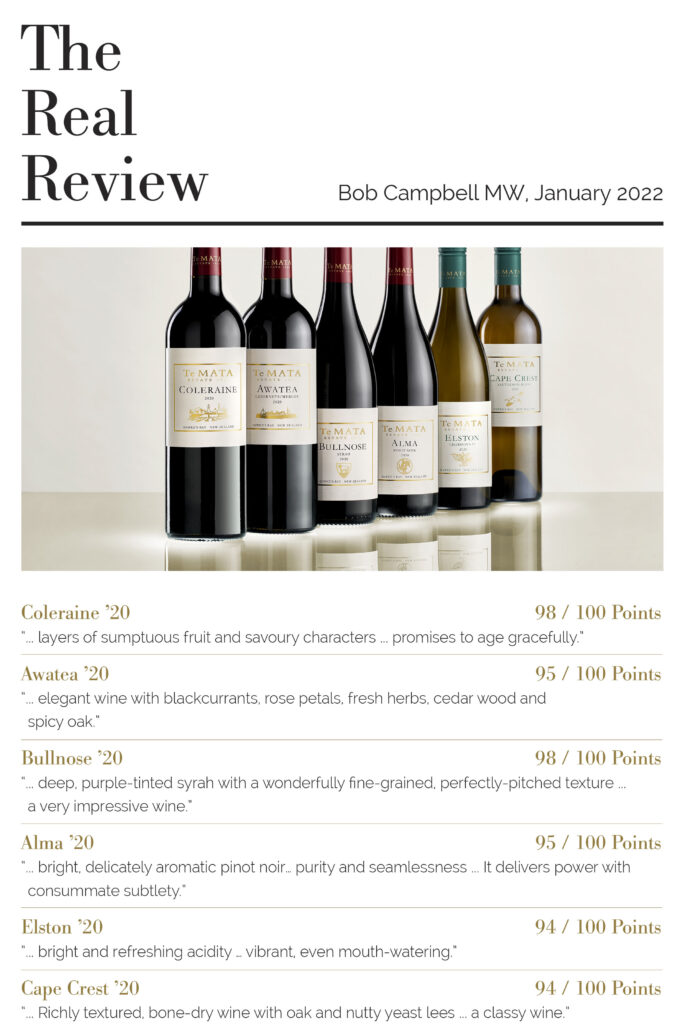Fresh from the Press
The Coleraine '23 reviews are in. And the reviews are superb.
5 Stars – Michael Cooper
‘Breed, rather than brute power, is the hallmark of Coleraine, estate-grown in the Havelock North Hills and matured in French oak barriques, predominantly new. This notably graceful red is a blend of cabernet sauvignon (80%), merlot (15%) and cabernet franc (5%). Dark and purple-flushed, it is mouthfilling with dense, well-ripened blackcurrent, plum and spice flavours, oak complexity, and a finely structured, very harmonious finish. Best drinking 2030+ (13.5% alc/vol).’
95+ Points – Gary Walsh, The Wine Front
‘I’ve tasted every vintage of Coleraine ever made. The acid line in this wine puts me in mind of the 2021. Blackcurrant, essence of Cabernet thing here, dried herbs (thyme) and nori, tobacco, pencil, liquorice/aniseed … with a very long finish. Wonderful perfume. I’m spending a lot of time thinking about this wine, about where it will go, and where it sits in the pantheon of Te Mata Coleraine, and the upshot is, ‘up’.’
98 Points – Sam Kim, Wine Orbit
‘The stunning bouquet reveals blackcurrant, dark plum, almond, cocoa, cake spice, and rich floral aromas with a hint of tobacco. It’s engaging and captivating and draws you in. The palate exhibits immense concentration and presence, superbly enhanced by silky texture and layers of chalky tannins. The acidity is perfectly pitched and provides freshness to this long-living wine. A wine of meticulous precision and undeniable sophistication. At its best: 2033 to 2053.’
Updated March 2025. Coleraine ’23 is available now at temata.co.nz.
6 September
Hawke's Bay Wine Auction 2024
Te Mata Estate has been a proud supporter of Cranford Hospice and Hawke’s Bay Wine Auction since the beginning and this unique, never before offered vertical of Bullnose is something we are very proud of.
Lot no. 24 – ‘30 years of Te Mata Bullnose Syrah 1992 – 2021’; first planted in 1990, the Bullnose vineyard’s red iron gravels produce our finest Syrah which show floral and spice aromas, rich flavours, and velvety texture. 25 bottles 1992 – 2021 excluding 94, 98, 07, 10, and 17.
View the auction catalogue here: https://hawkesbaywineauction.co.nz/2023-auction-catalogue/
Hawke’s Bay Wine Auction tickets are available now: https://hawkesbaywineauction.co.nz/event-details-2023/
Saturday 16 September at 12.30pm to 5pm at Toitoi HB Arts & Events Centre.

8 August
Time To Celebrate 30 Years Of Bullnose Success
Syrah is a typically fruity and peppery red wine usually in a dark colour and with a strong tannic mouthfeel. Popular all over the world, it is somewhat confusingly called ‘Shiraz’ in some parts – especially Australia. This is despite the ‘Syrah/Shiraz’ grape having nothing to do with its namesake city in Persia; as it definitely came from France as an ancient crossing of the Dureza and Mondeuse Blanche grapes. So, while both the Syrah and Shiraz wines come from exactly the same grape – give or take a clone here and there – how they differ is to the style of wine. Syrah is the variant made in cooler climates, like ours, while the Shiraz is native to the more hotter zones within Australia, South Africa and even France. Why the Aussies started calling their hot-climate Syrahs ‘Shiraz’, of all things, is unknown – even to them!
The Te Mata signature wine
Even though it’s popular here, Syrah is still rare in NZ with only 1% featuring in our vineyard plantings. But Te Mata Estate have made Syrah a centrepiece of their offering with an ever-expanding portfolio of Syrah vineyards to go with their original Bridge Pā planting. Since these Northern Rhône clones first went in to the fine red metal soils of Bridge Pā in 1990, Te Mata have added the mature Syrah vines at the nearby Hotspur and Ancestral vineyards. The goal obviously is to further develop Te Mata Estate’s much-awarded Bullnose Syrah. Named for the Morris-Cowley British sports car, with its Bullnose-shaped radiator, and bearing the car’s emblem on the label, Bullnose has come to represent the modern signature of the Te Mata Estate.
A much-awarded cool-climate art
Over the past three decades, Bullnose has become not only one of NZ’s most awarded Syrahs, but it has also become a premium global example of the cool-climate art. So much so that it has been used in the blind tasting section of the international Master of Wine exam. This on top of its regular appearances in James Suckling’s Top 50 Wines of the World and a listing in Wine Enthusiast Magazine’s ‘Top 20 Wines of the World’ last year.
Technical excellence grabbing global attention
Part of Bullnose’s appeal, and certainly as a Master of Wine exam test subject, is due to technical prowess demonstrated by Te Mata Estate’s team over the years in developing Bullnose into such a world-beater. The early vineyards and Northern Rhône clones have been looked after carefully over many Hawke’s Bay sunny summers and cool nights. As experience with the site has grown, hundreds of small steps of refinement have been made in viticultural management over thirty years. New vines have been added, and new vineyards too. At the winery, there’s new sorting equipment, more small fermentation tanks, a high-tech red wine fermentation room, and advancements in the Syrah-specific Rhône oak programme for barrel-ageing.
Bullnose – The Evolution Event
If you’re at all like these Masters of Wine around the world then you too will want to know just how Te Mata Estate have been able to make such delicious, velvety Syrah. And you’ll be in luck as Te Mata have organised a special event at Auckland’s The Hotel Britomart as part of the celebrations of thirty years of Bullnose Syrah. Here you’ll be able to witness firsthand the evolution of Bullnose and hear from Phil Brodie, the passionate and entertaining head winemaker at Te Mata who has made every Bullnose since the inaugural one in 1992. The evening will begin with an arrival wine and canapes, followed by a formal seated tasting of six Bullnose vintages of these exceptional wines from the very first 1992 to the latest superstar of 2021. A truly must-do event for every Syrah – and even Shiraz – fan!
What: Bullnose the Evolution
Where: The Hotel Britomart, Auckland
When: 11 October
Contact: Te Mata Estate for details – 0800 836 282 or [email protected]
Cy Sinderson, M2
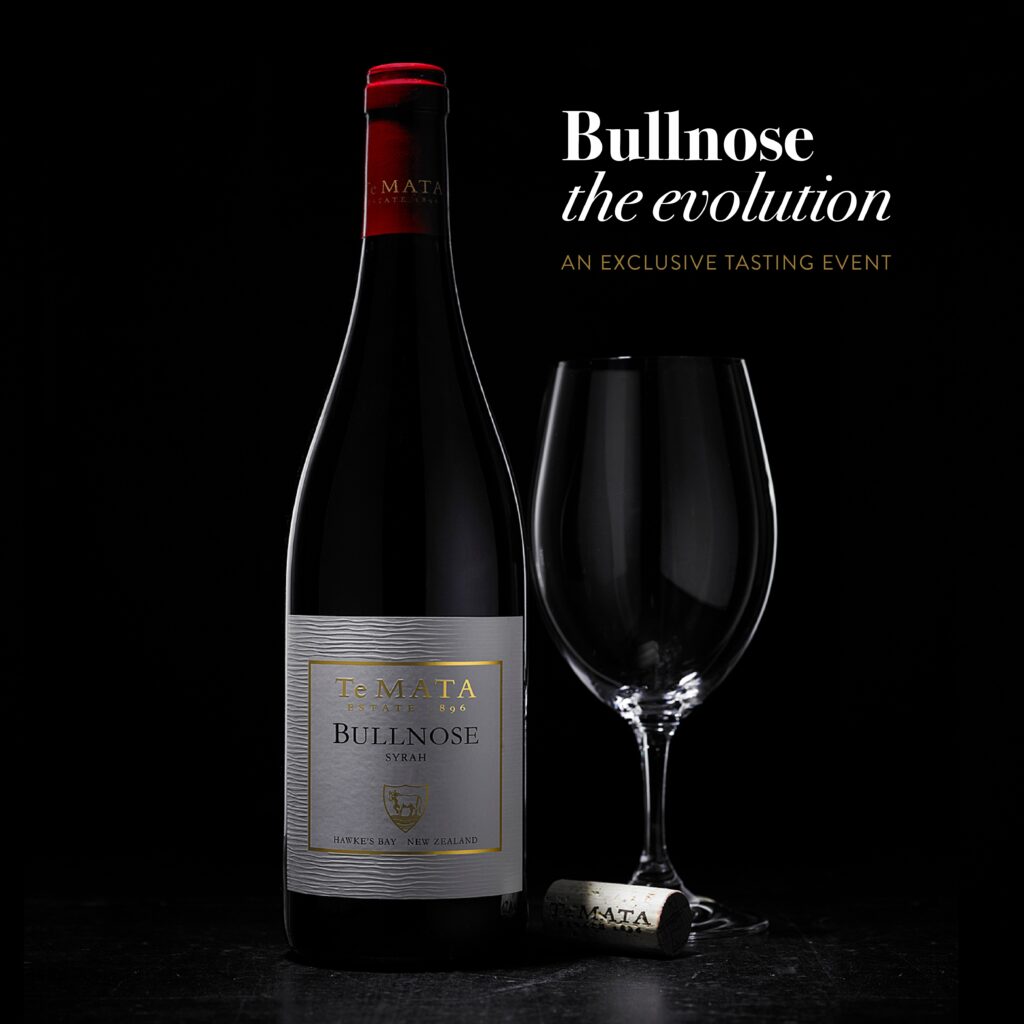
2 August
The Pinnacle Of Craft
The best in New Zealand; now that’s a lofty height. It’s a special zone with rarified air that only people like Sir Patrick Hogan, Lisa Carrington, Peter Beck, Zoi Sadowski-Synnott, Peter Jackson and Lydia Ko get to breathe. It’s also an amazing place where the All Blacks, Crusaders and Scott Robertson (and maybe Ian Foster too, we’ll see how that plays out over the next wee while) hang out licking their Kapiti Hokey Pokey ice creams and listening to SIX60 while they look out at Milford Sound and the Sky Tower at the same time.
And what would the wine be that all these people drink? Why, the very best in New Zealand of course – but how do you figure out what that is? There are so many very, very good wines around the traps here, how do you figure out which one is the absolute pinnacle of the craft?
You have to ask international wine judges of course, and once you do; one name regularly rises above all the others. Since its first production in 1982, Te Mata Estate’s Coleraine has been acclaimed as New Zealand’s greatest wine and the praise just keeps on coming from the critics: ‘New Zealand’s greatest red wine’ – Raymond Chan, Raymond Chan Wine Reviews; ‘Just glory’ – Andrew Graham, Australian Wine Review; ‘When Coleraine was first made in 1982, it was light years ahead of any New Zealand red wine produced before that date. It has since become the country’s most iconic wine label’ – Bob Campbell MW, Decanter; ‘one of New Zealand’s finest wines’ – James Suckling, JamesSuckling.com; ‘NZ’s Sassicaia’ – Neal Martin, Robert Parker’s Wine Advocate.
It is of little surprise they keep raving, Coleraine is a refined and classical Cabernet Sauvignon dominant wine, often with Merlot and Cabernet Franc. Very powerful in its youth, Coleraine develops over a substantial time frame and is renowned for its fragrance of ‘old roses’, with elegance and precision contained within a fine, dry, tannin structure.
Available now at www.temata.co.nz.
Cy Sinderson, M2
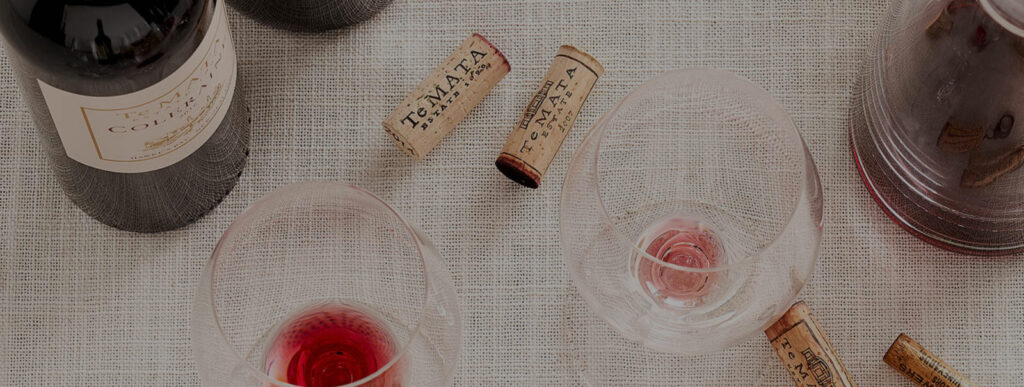
19 July
Te Mata – A National Treasure
National Treasures come in all shapes and sizes and in this case, flavours from the the oldest wine property in the country. Established in 1896, Te Mata is New Zealand’s original fine wine estate. Recently described by jancisrobinson.com as ‘A national treasure’, Te Mata Estate produces wines grown, hand-harvested, fermented, and bottled entirely on their nineteenth-century Hawke’s Bay estate.
And 124 years later in 2020, it’s fair to say that things have been a bit of a basketcase for many industries and sectors, but believe it or not there have actually been some positives that have come out of 2020 also. For Hawkes Bay wine producers, a hot dry summer has produced outstanding quality grapes. In a recent interview with BayBuzz, the chief executive of Te Mata Estate, Nick Buck, said that, “‘18, ’19, and ’20 have been amazing. We thought ’19 was amongst the best vintages we’ve seen, then along came ’20, and we’re blown away by the quality. The ‘20s are the most concentrated wines we’ve seen in the 46 years my family’s run Te Mata. It’s hard to pick a stand out variety as the quality is so strong across the board.”
Amy Thurlow, M2

15 June
Te Mata x Black Origin | Wine Pairing Dinner
Experience the perfect fusion of excellence at an exclusive collaboration between Te Mata Estate, Black Origin Beef Wagyu, and Harbour Society.
Savour internationally acclaimed wines from Te Mata Estate, grown in Hawke’s Bay’s ideal environment. Delight in the unmatched tenderness and flavours of Black Origin Beef Wagyu, a unique blend of Japanese breeding genetics and New Zealand’s finest resources.
Join us for this extraordinary event that celebrates the pinnacle of quality and luxury in an unforgettable five-course wine pairing dinner.
Make your reservation now: https://bit.ly/3oX3Qjb

9 June
Hawke's Bay - 12th Great Wine Capital
Te Mata Estate is proud to share the exciting news that Hawke’s Bay has been named as the 12th Great Wine Capital of the World.
It’s an honour for the local wine industry to be celebrated on a global scale for our innovation, passion, and commitment to excellence.
We look forward to sharing all that makes Hawke’s Bay a must-visit destination for wine lovers and travellers from all over the world.



8 June
Whatever You Like About Wine; This One Has It All
If the ‘Speed’ era Keanu Reeves came up to you right now and shouted in your face; ‘Pop Quiz; what is it that you like about wine?!’ What would you answer?
Well, it probably might take you a few moments to recover from the shock of seeing Keanu so young again – and the fact that he’d obviously traded in his John Wick look which has been working for him for a while now. But, once you’ve come to terms with those reality-bending concepts, you could put aside a little time to seriously consider what it is that makes a wine enjoyable for you.
Is it the fragrance? Or the potency? Or the colour? Or the tension? Or its purity? Or a combination of some or all of those attributes? Though Keanu might think there is a right or wrong answer to his question, he’d be the one who is wrong because there isn’t a binary solution. Different people like different wines for different reasons – and they’re all correct.
‘The One’
But what if you like potent wines with bold colour while your friends are purity, tension and fragrance fans? Surely someone’s going to miss out on their favourite! Now normally, this might is quite probably turn out to be the case. But every now and then something very special happens in Wine Land: a vintage comes out that has everything for everybody. These wines are rare, not through lack of trying as every winemaker hopes for the perfect vintage. But for in order for a vintage to exceed everyone’s wildest dreams; everything has to fall into place perfectly like temperature, dryness, sugars and acidity in a completed Rubik’s Cube puzzle of glory.
Incredibly, Te Mata Estate has just had one – the 2021 Vintage – and everyone in-house can’t help but refer to it in hushed, respectful tones as; ‘The One’. This is because, by quirks of fate and good management, everything fell exactly into place with The One. Even in the context of the recent strong vintages at Te Mata, The One is something else because it was mostly the result of an exceptional year weather-wise.
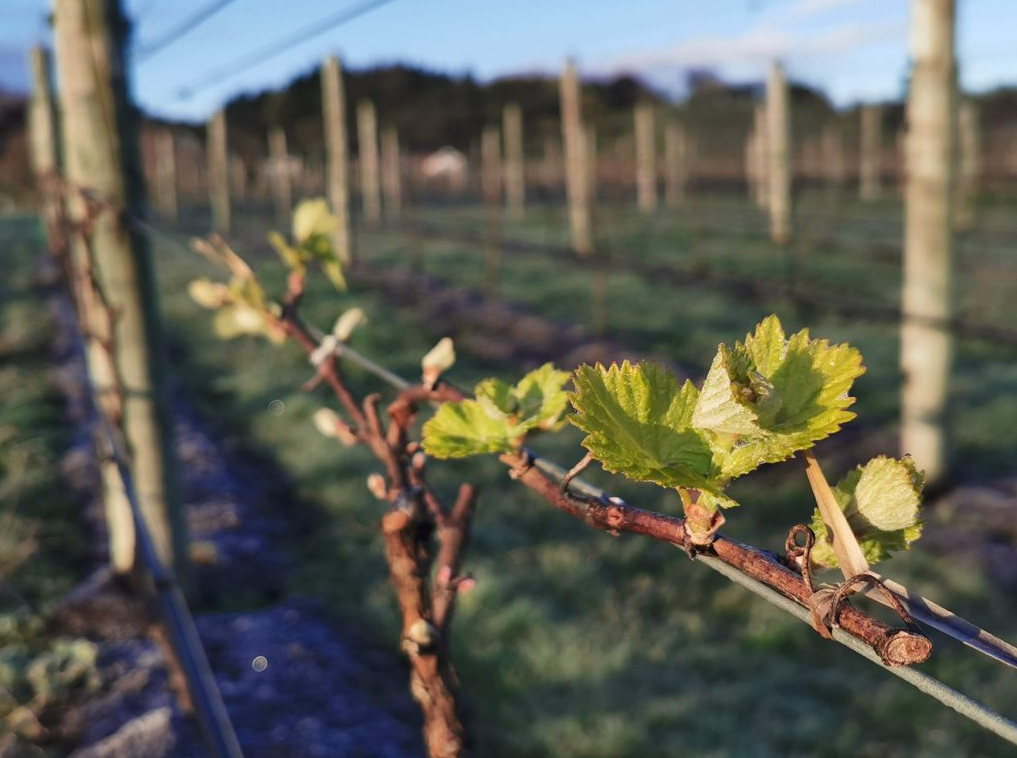
How The One became so singular
The 2021 Hawkes Bay winter was the warmest on record in New Zealand and very dry which led to the earliest budburst in Te Mata’s history. Whatever rain that did fall fell at exactly the right time to recharge the soil and grow some healthy, albeit low and full canopies. Then, soon after flowering, the rain stopped enough – i.e., between December through to February – to create mild levels of water stress. This stress of course is a vital factor in flavour development, making that year even more concentrated than usual. Add in the very small berries on both whites and reds and Te Mata had significantly lower yields than normal, both in cropping rates and juice. As a result, their whites have great concentration, intensity and tension, with wonderful natural acidity, and the reds are deeply coloured with plenty of extract and layer upon layer of fruit purity. This means the 2021 vintage has high definition wines with strong and elevated ‘varietal’ impact.
Above average heat summation followed by a tapering of Growing Degree Days over late January and into early February also led to the retention of the natural early harvest acids, adding to the wines’ varietal expression, balance and wonderful length.
So the Te Mata 2021 Vintage has wines with something for everyone; strong fragrance, tension, purity, power, and persistence – the only question left for Keanu to ask is; ‘Pop Quiz: do you have the patience to wait for The One to come out?’
Considering that the first wines from this Te Mata Estate 2021 vintage are already on the market – and the 2021 Showcase reds are just about to drop, then the universal answer very likely is; ‘Let me at ‘em now!’
Cy Sinderson, M2
30 May
The Coleraine ’21 from Te Mata Estate: The One
Hawke’s Bay, New Zealand is known for producing some of the world’s finest red wines, but since 1982, Te Mata’s Coleraine range has carved out it’s own benchmark and year on year it keeps getting lifted.
The 2021 vintage of Coleraine is a true standout, known among wine lovers as “The One.” The weather conditions throughout the region during the growing season were ideal, leading to an early bud break and harvest and producing grapes with exceptional purity, power, tension, and persistence. This stunning wine represents the epitome of the region’s multi-vineyard, sub-regional blending philosophy, showcasing the perfect harmony between cabernet vines and the soil and climate of Hawke’s Bay.
As soon as you pour a glass of Coleraine ’21, the deep crimson color with a royal purple edge hints at the wine’s exceptional character. The aromatics are an explosive mix of wild blackberry, blackcurrant, thyme, cedar, and the signature Coleraine perfume of fresh roses. The palate is a perfect balance of richness and vibrancy, with a modern and varietally expressive flavor profile of cassis, raspberry, mocha, spice, and a distinctive minerality that is unique to the 2021 vintage. The succulent fruit ripeness is complemented by profound, chiselled tannins that carry the palate on endlessly.
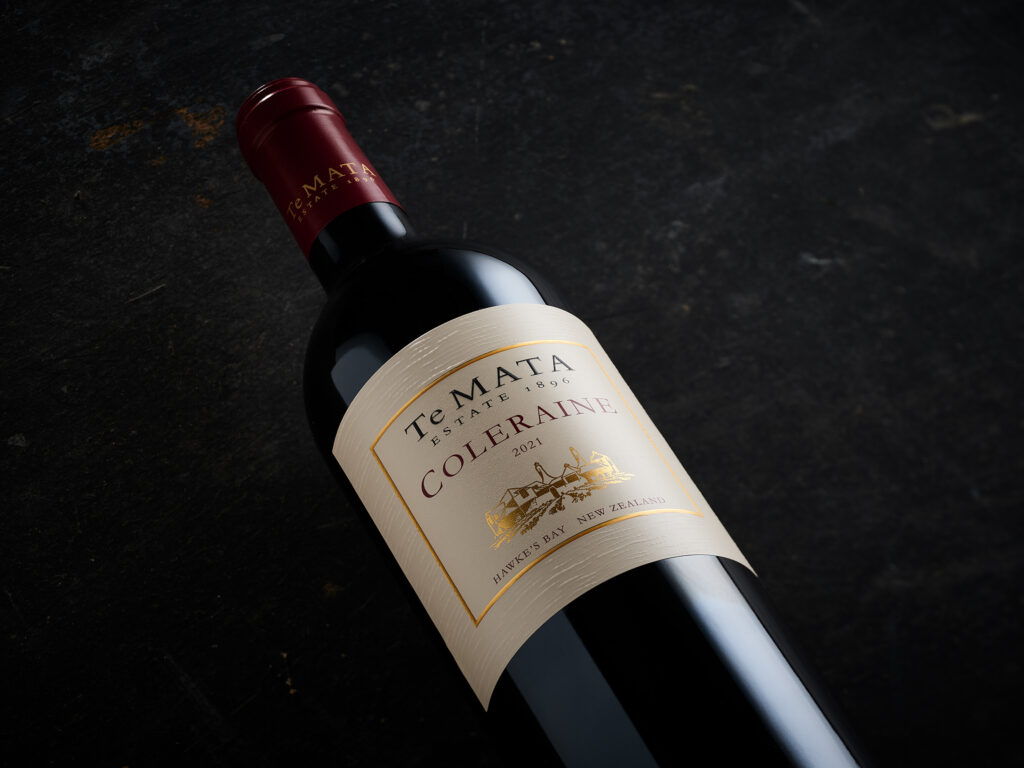
Wine critics are in agreement that the Coleraine ’21 is a truly remarkable wine. Huon Hooke from The Real Review notes that the wine shows a bouquet of mulberry, blackcurrant, and raspberry fruit aromas, along with a sprinkle of spices including nutmeg. The tannins are more persuasive and mouth-coating, and the length is prodigious. Gary Walsh from The Wine Front gave the Coleraine ’21 97+ points, describing it as “light but so dense,” with a fresh raspberry juiciness and an extra dimension of tension and energy.
The weather conditions that created the perfect growing season for the 2021 vintage of Coleraine are unlikely to be repeated any time soon. This means that the volume of Coleraine ’21 available is much lower than in previous years, and really is a wine that is truly one of a kind and may never be seen again.
Andrew Rowell, M2
28 March
2021 Showcase Wines
All our Showcase 2021 wines were released this March and have all received fantastic reviews – here’s a video to celebrate.
13 March
Te Mata Estate Supporting Cyclone Gabrielle Relief Fund
Webb’s Live Auction of the Coleraine ’21 large format 6L and 9L
We are so pleased to be collaborating with New Zealand’s premier auction house Webb’s to support the Cyclone Gabrielle Relief Fund for the Hawke’s Bay Winegrowers Charitable Trust.
Te Mata is donating a 6 and 9 Litre of Coleraine ’21 – ‘The One’
All proceeds – hammer price + buyers premium – to be donated to Hawke’s Bay Winegrowers Charitable Trust who will match donations up to $30,000 to support in the recovery from Cyclone Gabrielle.
Auction Details
An online auction and a Coleraine tasting pre-auction at Webb’s new Wellington retail space.
Wednesday, 15th March.
6.30pm Start time (doors open at 4.30pm, Coleraine tasting is at 5.30pm)
Address: Webb’s, 23 Marion St, Te Aro, Wellington
Registration
online at webbs.co.nz
www.auctions.webbs.co.nz/m/login/
Auckland + 64 9 529 5600 Wellington +64 4 555 6001
Email: [email protected]

1 March
Cyclone Gabrielle Update
The Te Mata Cellar Door is open for Tastings and Sales 7 days a week. We are fortunate that our vines were not badly damaged in the cyclone and we have begun harvest.
Please note there may be some delivery delays for online orders, due to road closures.
To everyone affected across the country, we hope you are safe and well. Our thoughts are with you all.

21 February
25 Years in Australia with Red & White
This year Te Mata Estate and Red & White celebrate a 25-year partnership in the Australian market. We are so proud of this enduring and successful relationship which is a significant milestone in Te Mata’s ongoing development in Australia. Nick Buck (CEO), Vince Labat (Commercial Sales Mgr) and Matt Fitz-Gerald (Australia Mkt Mgr) were in Australia last week for a string of events in Melbourne, Sydney, and Brisbane to launch the Coleraine ’21 and celebrate the 25-year partnership with the Red & White team.
Nick Buck says “ We have a long history with Red & White which goes from strength to strength and it has always been a great pleasure to work with them. John Valmorbida and his team are at the very top of their game and we couldn’t think of any better partner to work with to develop the Te Mata brand in Australia. We celebrate our 25-year anniversary by launching one of our very best wines Coleraine ’21 and at the same time presenting the Coleraine ’98 from the birth year of our collaboration. We look forward to many successful years ahead to continue building our relationships in Australia”.
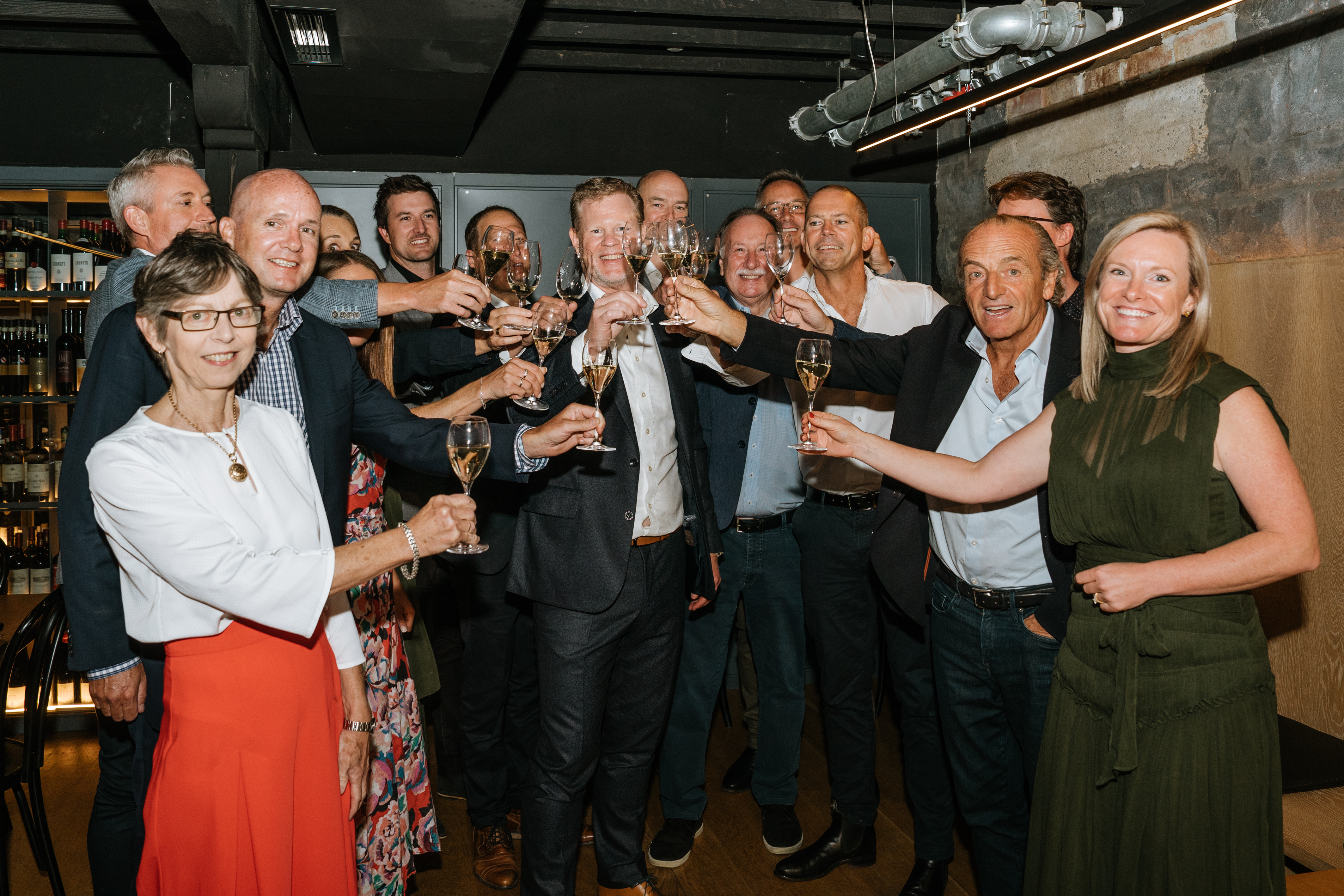


10 February
Showcase Auckland 2023
Showcase is coming to Auckland for two nights in 2023
Tuesday 7 and Wednesday 8 March
Join us to celebrate the latest release of Coleraine and other Showcase wines from the historic 2021 harvest.
Spaces are limited, buy your tickets here.

6 January
'Lessons from an exile' - Toby Buck
Toby Buck, our UK & EU Brand Ambassador, recently wrote ‘Lessons from an exile’, featured on Jancis Robinson.com.
Toby talks about vintage 2020, the fear of the pandemic, and his time in Amsterdam where he has unexpectedly spent ‘three cold European winters’.
We’re proud to share this composition with you, take a moment to enjoy the read with your favourite glass of Te Mata here: https://www.jancisrobinson.com/articles/lessons-exile
Photograph of Toby testing the ice in Amsterdam.

9 December
Coleraine '20 in the Top 10 Wines of NZ for 2022

11 November
Terrific reviews from Gary Walsh at The Wine Front!
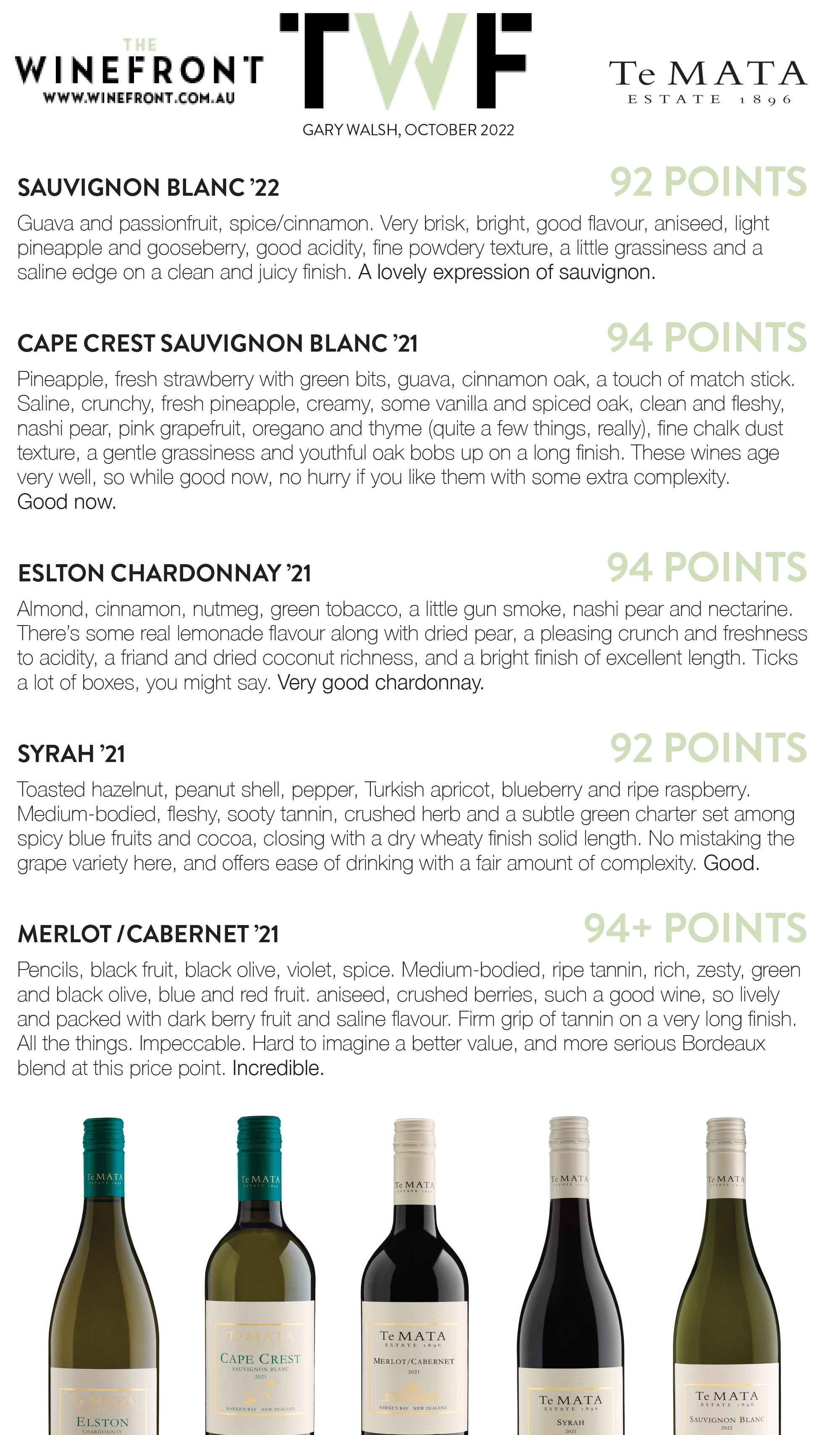
9 September
Rare Coleraine Vertical Donated to Charity
As published in NZ Herald, September 2022:
A “remarkable” 26-bottle set of Te Mata Estate Coleraine vintage wines will go under the hammer at the 30th Hawke’s Bay Wine Auction.
The in-person event is being held on September 17 at Toitoi HB Arts and Events Centre and includes bespoke, one-off wines from some of the most prestigious wineries in Hawke’s Bay, collaborations between winemakers, luxury accommodation and restaurants, and a travel package. The auction also has a feature art piece, which this year is by John Lancashire.
One of the biggest draws is set to be a 26 vintage vertical of Te Mata Estate Coleraine, which has been generously contributed by sponsors Isaacs Plumbing, Pumping and Electrical. This Te Mata Coleraine vertical of 26 vintages covers the span of 1994 to 2020 (minus non-producing 2012).
Since the release of the first vintage in 1982, Te Mata Coleraine has established itself as one of New Zealand’s greatest red wines, its annual release always selling out. In March 2021, a single 750ml bottle of Te Mata Coleraine sold for more than $1000, a new record for any NZ wine at a commercial auction.

Te Mata Estate chief executive Nick Buck said Coleraine collections being offered for sale are rare, especially verticals like this, due to the time it takes to assemble them. “We know of only five verticals that have ever been offered for sale. Their rarity always creates extra interest.
“Isaacs’ donation of this […] for Cranford Hospice is extraordinarily generous and a fantastic opportunity for the successful bidder.”
Isaacs’ director Gavin Streete said the donation had “real meaning”, as a team member had gone through Cranford recently. “We will be there on the day and look forward to the auction – here’s hoping that we set another record for this amazing charity.”
Coleraine derives its name from the town in Northern Ireland where John Buck’s late grandfather was born, and is a blend of Cabernet Sauvignon, Merlot and Cabernet Franc.
22 August
The World Upside Down - Tobias Buck
Tobias Buck recently submitted ‘The World Upside Down’ to the 2022 Jancis Robinson Wine Writing Competition, which discusses contemporary regenerative practices in a 130-year-old New Zealand cabernet vineyard.
Photographs by Carl Gunderson, Vineyard Manager
There’s a series of tree photographs by Canadian artist Rodney Graham taken with the camera upside down. The branches and leaves of the tree in the inverted image reach downwards, like an entire root system made visible. A system for sequestration holding on to the edge of the planet. Every spore, nodule, and tendril is exposed. A usually-hidden, interconnected, underground kingdom captured in high definition.
There’s a print of this image in a cottage that sits low among Cabernet vines, at the foothills of Te Mata Peak on the East Coast of New Zealand. The Māori name for this region, about halfway up the North Island, is Te Matau-a-Māui – the hook of Māui – since the long north-to-south curving bay facing east towards the Pacific ends in a sharp upwards point. Just like the jawbone it was said Maui used to fish the North Island from the ocean’s depths.
Te Mata Peak itself is the eastern highpoint of a Triassic greywacke range, lifted from the prehistoric sea floor over millennia like a slowly rising wave. Its full name is Te Mata o Rongokako, and it resembles a giant lying flat on his back as if in funerary repose. The few hectares of Cabernet vineyards, in the north-facing foothills, are some of the first vines in the world to see the sun. When morning fog settles it’s said to be the white-feather cloak, signifying prestige, softly laid across the solemn figure of Rongokako, the sleeping giant.
It’s a quiet place. There’s a deep port nearby, taking fruit and produce overseas, but it’s a spot not typically visited by tourists travelling via New Zealand’s central motorways or city airports. In Autumn, the morning mists drift between vines and slowly disperse as the sun rises – retreating inch-by-inch across farms, rivers, and fields. Tiny ice crystals remain behind, settled precariously on the grass. Standing in these gently rolling vineyards, with Te Mata Peak behind you, on your left you’d see snow-capped mountains in the distance. Standing in the rain-shadow of that chain, you’d also see on your right a pale blue horizon where the sparkling Pacific reflects back up into the sky. Throughout the year cool breezes float in from the coast, rippling gently across the canopy.
The foothills are covered in loess, and fine deposits of silica, limestone and pumice from when the volcano of Lake Taupō violently erupted two thousand years ago. Cabernet vines were first planted here 130 years ago, on the advice of a French visitor. There’s free-draining sandy loam and clay loam towards the middle of the hillside, and an underlying silica pan below that. You can see clay at the back of the sites, where they cut into the rising banks of the peak.
Since my parents and brothers (and many others with them) have planted vines here, as a kid I was responsible for unclogging the drip irrigators for young vines. I’d ride a tiny red motorbike up and down rows following the warm dark water lines that snaked across the dry soil. Sometimes I had to suck the soil out of the stuck nozzles to get them going. If you lean too far forward the water doing this, the water comes out your nose.
Across the road are New Zealand’s oldest operating wine cellars, where reds have been made for over a century. The place is an odd, and early, exception to the New Zealand wine story. By 1909 it was the country’s biggest producer, making and exporting Cabernet Sauvignon and Chardonnay from these hillside sites. The winery here has always teetered on the verge of something symbolic – the realisation perhaps of a romantic dream inside New Zealand’s pastoral heritage; an embodiment, or idealisation of it. The contemporary estate is a restoration of the original’s ambition – sharing with it the aim to create sophisticated claret in the Antipodes and have it celebrated in the Old World and beyond.
To be up there with the world’s best and yet be made in our own backyard, is a very Kiwi dream. The feeling is a bit like beating the English at cricket. Or rugby. Or sailing. Or anything really. The hope, that hovers over these Cabernet sites too, has always been to turn the world of wine on its head. To be the tail that wags the dog. Every step here the rejuvenation of estate is undertaken with that in mind.
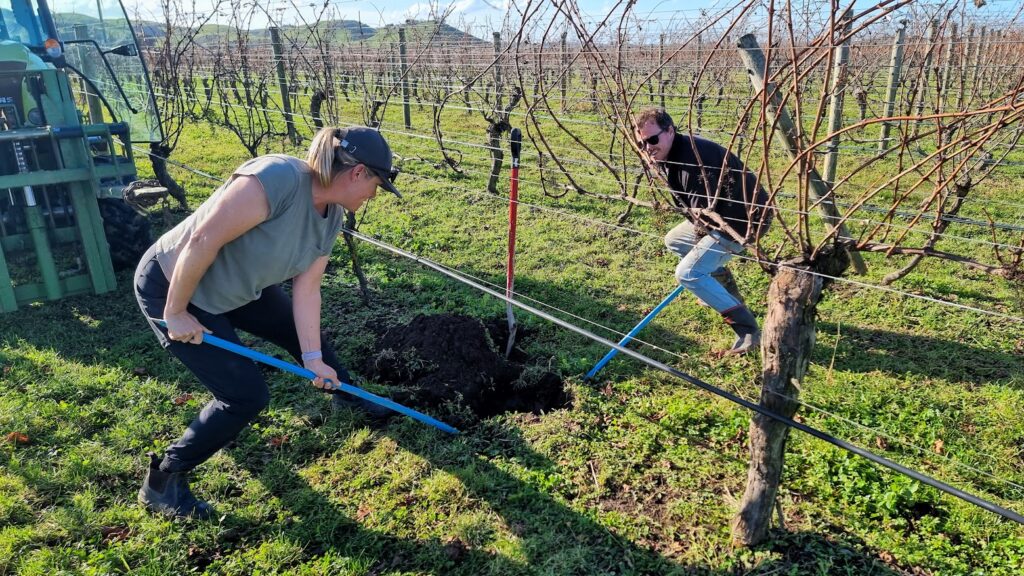
New Zealand’s environmental image is a fractured one. Visually, it’s a breath-taking place, but the ‘clean and green’ rhetoric is belied somewhat by a history of aggressive agricultural traditions established under the economic pressures of becoming one of the world’s preeminent greengrocers.
It’s a peripheral place too, or at least that’s how it can feel to live there. Interstitial. Temporary. Full of arrivals and departures. Before the country was mapped it was surmised to be the great counter-continent, even promoted and sold as some kind of tabula rasa. Samuel Butler’s 1872 novel based on his time here is titled Erewhon – the word ‘nowhere’ read back to front. Philosopher Karl Popper, who lived in New Zealand in the 1940s, described it as “infinitely remote … the farthest place in the world”. As a locus consistently-reimagined, it seems oddly apt to often function now as a convenient film stand-in for whatever fictive location is required.
The early fine wine industry faced many challenges, from phylloxera to being almost entirely stamped out by The Temperance movement of the 1930s. Being a country that established itself in the age of industrialisation, practices of industrial-scale farming and Post-WWII heavy agriculture were put into effect with almost-complete automacy. Attempts in viticulture to reckon with powdery and downy mildew, as an example, led to a heavy chemistry and a distinct metallic soil imprint. Continuous farming in areas throughout the country left soils depleted in nitrogen and occasionally laden too with copper and sulphur, both highly toxic to microbial life.
On these Cabernet vineyards people are now at work with a new approach – a sensitive agriculture with high-levels of empiricism behind it. Enabling these sites to produce the best Cabernet Sauvignon expression possible has required overlapping phases of regenerative farming and precision agriculture practices.
As it was developed in Nebraska, regenerative agriculture wasn’t created for vineyards, but the methods for grabbing carbon from the atmosphere and holding onto it in the soil, can still be applied. The objective is the same, to make the soil into a carbon-sink and move away from heavy-tilling that burns off carbon dioxide. Around the world amounts of CO2 go up in spring, as bare earth is turned and soil matter is exposed to the air.
On these vineyards there are ten-hectare organic trial-plots, with multiple seasons of data. Certifications can be prescriptive so the viticultural and management team here cherry-pick systems and practices by testing them onsite. Minimal cultivation methods are used and rotating cover crops break up the vineyard’s mono-culture. On 33-year-old vines, a spray from cow manure (in pits with crushed egg shells and basalt dust) is put down in Autumn and Spring, inoculating soil with microbes from the cow’s gut. It’s already getting results.
The Eastern Institute of Technology that teaches winemaking and viticulture in Hawke’s Bay has a classroom trial on one site, experimenting with hyperaccumulators of copper and other residual metals. It’s early days but they’re planting basil and winter spinach, testing whether it can be effectively grown small-scale then later dispersed.
Since 2020 a new Cabernet Sauvignon Entav clone has been planted, the latest and most promising from Bordeaux and one the winery has exclusive rights to use. The young vines are mostly farmed for wood at this stage, collecting buds for more extensive plantings.
Initiatives like this attract young winemakers from all over the world. The cottage has cellar hands in it mostly and over the last few years they’ve come from the USA, France, Italy and Spain. Every cuisine has been attempted on the barbeque there. The merits of many bottles, vintages, and wine cultures have been robustly discussed.

Since the five rivers of Hawke’s Bay have maintained wandering paths through the region over thousands of years, and complex tectonic movement has repeatedly raised and lowered sites, the diversity of microclimates in the region is extensive. Patches of high vigour can be as common as low vigour ones. A short drive inland, two of the estate’s vineyards – with Cabernet, Cabernet Franc, and Syrah vines dating back three decades – have parcels planted also with chicory and plantain to reduce their vigour.
Compost is used under vine and, in low vigour areas, there’s also mowing there to conserve moisture. As the organic matter is built into the soil it sequesters carbon from the air and adds biomass, a practice straight from the playbook of regenerative farming. One of the cereal crops being trialled is Triticale – a hybrid of wheat (Triticum) and rye (Secale) that grows up to two feet high. Crimson Clover, planted here too, will grow up to six inches and is used to fix nitrogen levels in the soil.
Both are sown in the Autumn and terminated in Spring, with a crimp roll before the first frost to get microbes in the soil started on eating the thatch. On the foothills of Te Mata Peak, Cabernet and Merlot blocks are planted with cover-crops of clovers, lentils, peas, broad beans, and blue lupins – grabbing up to 200 kg of nitrogen per hectare, per year. Planted every second row, these too are terminated in Spring to build carbon and organic matter back into the soil.
There’s hives nearby since part of the estate backs onto the pale yellow buildings of Arataki Honey. Buckwheat, Phacelia, and Alyssum, are planted every tenth row to bring in parasitic insects that kill mealybugs and prevent the spread of leafroller caterpillars. Lazy bees and tiny quick wasps seem particularly drawn to the bluest flowers in the vineyard. A favourite summer pastime with kids is waiting until the sun goes down, and the bees have wobbled home, then taking out a torch among the vines to spotlight the biggest wildflowers you can find.
Outside the cottage, with its picture of the upside down tree, are rows of Cabernet. The entire vineyard has been mapped with an Normalised Difference Vegetation Index camera, to see how green something is, and all vines tested with a Soil Moisture Reader. Heat maps have been made using this data, ground sensors, and satellite and drone imagery. Three rows just near the house were categorised as high vigour.
The desirable objective is to induce a balance of water stress in the vine after flowering. The right amount of water must be delivered, at the right time for the root system, to reduce the vines’ ability to create methoxypyrazines, while still enabling their ability to degrade them quickly. A balance to be achieved in consideration of crop size and a smaller leaf canopy.
The heat maps are also used to help create an application. For these three rows a devigorating cover-crop-mix containing chicory and plantain is put down every other row, then mown under vine to induce competition. The sowing of these seeds, precisely done down to a few inches, and the application of composts, is controlled automatically by live geo-location. More than just tractors with antennas, it’s precision agriculture in action. The dispersal controls, and rates, are set based on data collated about these soils and each vine’s individual ecosystem.
Only what is required is applied, and only where it is needed. As a result the site is more even overall to manage, with less waste, and has been consistently improving on its performance. Cabernet Sauvignon from here now contributes to the estate’s most sought-after red wine.
*
For a moment the estate had both the oldest and the newest cellars in the country. The winery has just completed the redevelopment of its fermentation rooms. Mirroring the vineyard developments a new and updated cuverie allows even more batch ferments. Separating these small vineyards into even smaller parcels. Garnering complexity rather than increasing volume.
Even though the recent run of vintages have been some of Hawke’s Bay’s best, global recognition for the region still hovers at a threshold point. The remoteness of the place, the tyranny of distance, means ageable examples are rare in the market, and our regional voice is a tiny one in the vast world of wine.
As farmers, and as a wine family, we take inspiration from the land and the need to preserve its character. The winery led the protection of the area from property development when it was classified in 1996 as a Special Character Zone. But, a reality too, is that our own interests have dovetailed with the long-term vitality of the place in which we live.
We have become our wines. Living on these remarkable pieces of land has changed who we are. Our estate has to be sustainable for there to be a viable legacy to continue for the many people involved. People, processes, and tools, working in harmony to sustain the entire ecosystem of our pocket-universe.

This year I attended my first Prowein conference. To look as professional as I thought I should, I bought a blue shirt, brown shoes, and sand-coloured pants. Stepping from the tram at the event centre I’m enveloped by a sea of folk dressed just like me. I immediately start pondering what confluence of cultural choices – mine and others – have brought me to this point. I wonder if I will speak in someone else’s voice or my own.
Did we all unblock irrigators the same way? There’s a chance but, honestly, I’m a bit nervous to ask. I keep checking there’s business cards in my pockets. New Zealand’s been closed for the last two years, as has much of the world, and the latest vintages are only just reaching the market. I’m encouraged by friends and customers to get over such doubts and just tell our wines’ story. The story of our place, our vineyards, and where we’re from. Maybe the mists may have parted for a minute. Maybe all the world will see. I hope so. This might be the only chance I get.
8 August
Estate Sauvignon Blanc '21 - 91 Points and Highly Recommended by DECANTER

5 August 2022
The Best Sauvignon Blanc in New Zealand - WineTourism.com
Te Mata Estate Winery is one of the best wineries in New Zealand to taste Sauvignon Blanc wine according to WineTourism.com
Learn more about this immensely popular and unique variety here: https://www.winetourism.com/sauvignon-blanc/

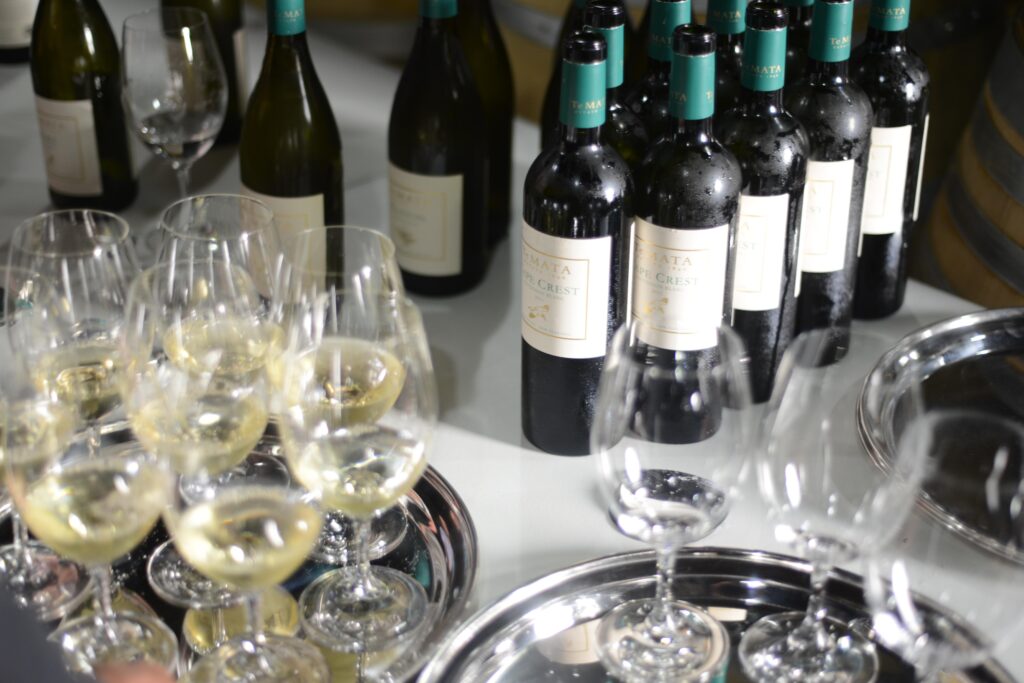
4 July 2022
The Real Review - Wine of the Week
98 points and ★★★★★! Thank you Bob Campbell at The Real Review for this outstanding review on our Bullnose Syrah ’20.
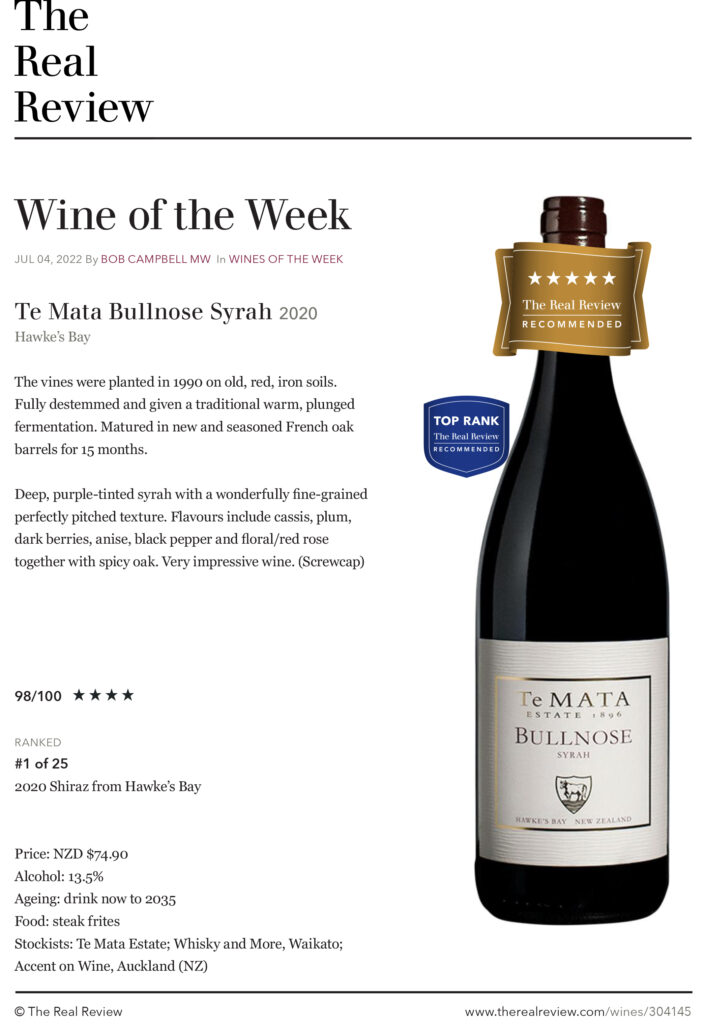
10 June 2022
Larry Morgan QSM
We’re proud to share the news that in the 2022 Queen’s Honours List, Larry Morgan – Te Mata Estate’s viticulturist for many years – was awarded a Queen’s Service Medal for his services to viticulture and canoe sports.
A student of famed New Zealand viticulturist Dr Richard Smart, Larry was at Te Mata for 27 years, with nine as our Senior Viticulturist. Especially known across the country as a leader in education and innovation, Larry is still very much involved at Te Mata.
His lasting contribution to the estate has been immense. We offer our sincere congratulations.

Larry (far right) with NZ’s newest cabernet clones arriving for planting
“He has spent his lifetime quietly bringing hard work, loyalty and commitment to everything he does – whether that be for his family, his leisure pursuits or in his career. This honour is so well-deserved, and we are very proud of his past and continued association with Te Mata Estate.
Congratulations Larry!”
– Nick Buck CEO
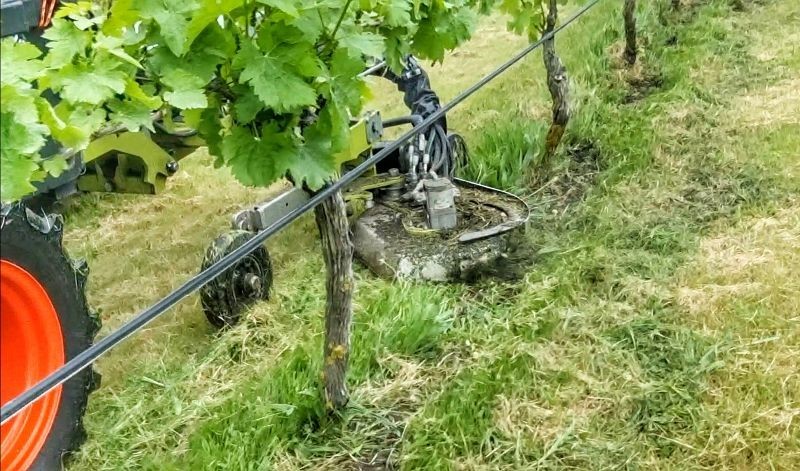
Larry is not only the leader of our picking teams (known as ‘The Larry-kins’) he is also a well-respected master in the field of viticultural science. Just one of his legacies at Te Mata, and in NZ wine, is his development of Precision Agriculture techniques.
Satellite imagery, drone imagery, and ground sensors, are all used to generate heat maps that access vine vigour. An application is then developed, based on that data. That’s then put into action, at pre-determined rates and locations, by using a real-time GPS live-feed connection between tractor and satellite.
From watering, to under-vine mowing, to planting seed-mixes that induce competition around vines – this a carefully calibrated practice that improves sustainability by only using what is required, where it is required.
18 May 2022
NZ Annual Trade Tasting London - Matthew Jukes Top 40
Last week our Toby Buck represented Te Mata at the NZ Trade Tasting in London. Coleraine, Bullnose and Elston were all featured in Matthew Juke’s NZ Top 40 out of 250+ wines tasted.
Wednesday Wines – Episode 108 – The NZ Top 40
23 April 2022
Te Mata Showcase 2022
Showcase is coming to Auckland, Wellington and Hawke’s Bay in May 2022.
Join us for a celebration of Vintage 2020 – A Perfect Vision – and the most compelling line up yet of Te Mata’s premium collection. Taste, experience and learn about these wines with the people who make them.
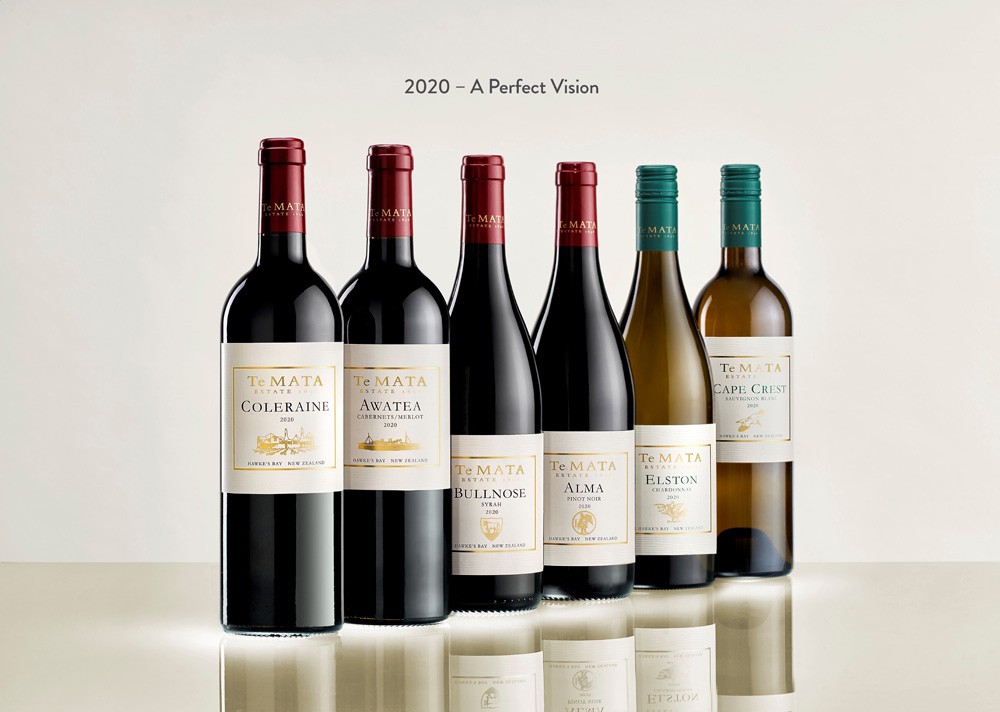
1 March 2022
Today is the official release of Coleraine 2020 – A perfect Vision
“2020 was simply perfect and will go down in the history books as one of the best on record”
Nick Buck, CEO Te Mata Estate
With this theme and these words we are thrilled to receive a perfect 100 point score from wine critic
Sam Kim at Wine Orbit.

2 February 2022
COLERAINE '20
Coleraine ’20 is almost here and we are beyond excited.
We’ve already had some fantastic reviews…
Unbelievably good. Young, but the potential is overwhelmingly potent. Floral, nutty, intense small-berried fruit, cedar, anise and sweet herb. Tight, medium-bodied, so concentrated, but light too, ultra-mineral, fresh, all the gravel and tense cabernet feel, but with perfume unlocked: so flagrant and fragrant. The length is superb. I’m taken aback by the beauty and essence-like nature of this wine. My precious. Easily one of the best wines I’ve tasted in the last decade. 98+ Points The Wine Front, Gary Walsh, Australia, December 2021
Very deep, bold, bright purple/red colour, the aromas similarly impressive for their concentration and vibrancy. The wine is super-concentrated and loaded with drying, savoury tannins that add a smidgin of bitterness that helps cleanse the aftertaste, which is formidably long. A sensational cabernet blend, gorgeously flavoured and perfumed, profound and lingering. It has the intensity and structure to age long-term. The patient will be handsomely rewarded. 97 Points ★★★★★ The Real Review, Huon Hooke, January 2021
New reviews from Bob Campbell MW for all our 2020 Showcase wines.
The 2021 release of Coleraine is limited.
If you’re not already on our database please register your interest at [email protected].
5 November 2021
COLERAINE '18
ONE OF THE WORLD'S MOST CELLAR WORTHY WINES
Te Mata Estate’s Coleraine 2018 has been selected in the TOP 100 Cellar Selections list for 2021 by the Wine Enthusiast Magazine. Selected amongst wines from the greatest wine regions of the world and one of only two New Zealand wines to achieve this.
The Wine Enthusiast is a world-renowned wine publication, and one of the most influential voices in wine and drinks journalism today. The expert wine panel, taste and review 20,000 wines a year, and make their selections. The 2018 Coleraine was Awarded 96 points by Christina Pickard, editor of The Wine Enthusiast who reviewed the wine.
“Each year, we release the Top 100 Cellar Selections list, a ranking of the best wines tasted throughout the year that exhibit pedigree, structure and staying power—the hallmarks of age worthy wines. All these bottles will stand the test of time ... This vintage is a strong one, showcasing the power and ageability of a world-class red with the precision of this traditional estate.”
Nick Buck, Te Mata’s CEO, is proud and delighted:
“This recognition by one of the world’s foremost wine publications is fantastic. It shows that Hawke’s Bay and New Zealand can produce serious, age worthy wines that compare to the best in the world. We are proud of this as it endorses all the focus and attention to detail we put into this wine and it’s very rewarding to see that acknowledged.”
“Coleraine is a wine that collectors have cellared for many years since we first produced it in 1982. The 2018 was an excellent vintage and we are very excited to release the 2020 in March next year.”





